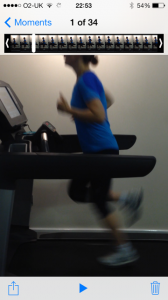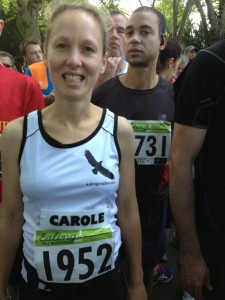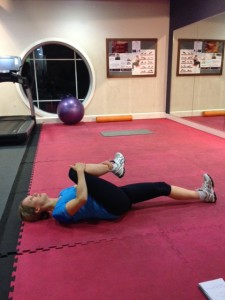
About to run an important race? Apparently, the most important night for performance-boosting good sleep is the one two evenings before your big event. ‘Anxiety stops you from sleeping well the night before a race, so you can effectively count that one out,’ says my running coach Scott Mitchell, of Move Running. ‘But do aim for a good sleep the night before that.’
However, no-one told my two-year-old. Two nights before the half marathon, my toddler woke me up in the middle of the night, vomiting. The poor little scrap was awake for about five hours – and that meant so was I. The next morning, I was exhausted. It wasn’t the most glorious start to the countdown for my big race.

Everyone pronates their feet to some degree – and this is entirely natural and the body’s way of cushioning from the impact of pounding the ground – but Scott’s concerns about my feet positioning have now diminished. ‘It’s how you control the pronation that’s the problem,’ he says, ‘and you are controlling it much better now because your knee is no longer swinging in.’ I’m really chuffed.
Click here to see my first running video when I started coaching with Scott, and click here to see my running now post-running rehab.
On the morning of the Ealing half marathon, it’s sunny and bright. Perfect weather for a run. But I still have my fears – during my last long training run two weeks ago, my knee was aching, and I’m still not sure if it’ll hold out. But I’m going to give it a try.

Then I turn into Ealing’s pretty Lammas Park for the final metres, and see family and friends cheering me on. I’d like to say that their cheers acted like rocket fuel. But that would be a lie. Seeing them was still a great boost though. Somehow I pulled a sprint finish out of my creaky old bag, and came in at a personal best of just under 1hr 49 mins.
Exhausted? Yes. Sore muscles? Absolutely. Dodgy knee? No, amazingly. In fact it didn’t twinge once. All that coaching from Scott and those targeted strengthening exercises finally paid off. I’m so grateful to him for getting me through – I only wish I’d sought running training years ago.
Want to improve your running? Here are Scott’s TOP TIPS
- Buy your running shoes at the end of the day
Your shoes are the most important piece of your kit, so get fitted at a specialist running shop, preferably one in which the staff are keen runners and so understand your needs. But aim to go at the end of the day – or at least at the end of your shopping trip. ‘When you put weight on your feet through the day, you stretch out the ligaments and gravity drives fluid into your legs,’ says Scott. ‘This makes your feet a little bit flatter and bigger. By shopping for running shoes when your feet are at their biggest, you’ll get shoes that fit you.’
- Plan your training schedule carefully
To avoid injuries, it pays to plan the progression of your training, making sure you give yourself enough time to build up the miles sensibly. ‘Beginners tend to improve quickest over the earlier stages of their training,’ says Scott. ‘But often people make the mistake of expecting that rate of improvement to continue, so they increase the distances too quickly.’ He advises giving yourself a few weeks to – effectively – find your feet, and then increase your long run’s distance by no more than 10 per cent each week.
- Include strengthening exercises
A range of exercises, such as Cook hip lifts, shoulder bridges, lunges and single leg Romanian dead lifts can all help strengthen your body for running. Click here and here for links to my previous running rehab blogs for exercises that can help you. For more specific exercises tailored to your body’s needs, it’s a good idea to see a sports physiotherapist.
- Pick up your feet when you run
This is an important general tip for honing running technique. ‘Everyone should focus on getting their feet off the ground quickly and picking up their feet nice and high,’ says Scott. ‘But make sure you bring your feet up under your bum, not behind it.’
- Don’t over-stride
The other way to improve your running technique, is to make sure you don’t build speed by lengthening your stride. You’ll only end up striking the ground with your heel, which can lead to injury. Instead make sure your foot lands under your body. To boost speed, make sure your foot leaves the ground fast and take more steps. ‘It’s a much more effective and safer way to run than having a long, slow stride,’ says Scott.
- Try an ice massage
Make sure you stretch diligently post-run, and if you’re still feeling sore, massage ice cubes over the affected area. Rest for a few days.
- See a specialist
If a part of your body still feels sore after a few days of ice massages, stretching and rest, don’t dilly around, but book an appointment with a physiotherapist or podiatrist, preferably with a background in running or biomechanics. ‘The longer you leave an injury, the more likely you are to get knock-on effects elsewhere in your body, for example, tightness in the other joints and muscle weakness,’ says Scott. ‘These things will take longer to fix.’
It’s really important to stretch after a run if you want to avoid injury. Here are Scott’s top 3 post-run stretches:
8. Glute stretches

9. Lunges
Stretch your hamstrings and hip flexors by holding a lunge. Hands on your hips, place your leg at a right angle and push into a lunge. Let your knee rest on the floor, making sure your knee and ankle are in a straight line. Keep your back leg straight. Hold for a minute before switching sides.
10. Calf stretches
Stand on the bottom step of stairs with the edge of the step under the centre of one foot. Lower the heel of this foot for a strong stretch in the back of your calf, keeping the other knee loosely bent. Hold for a minute before switching sides.
Carole’s coach
A physiotherapist and running coach, Scott has wide experience in managing musculoskeletal conditions, including running injuries. A runner, he has represented Australia at the Oceania Games in the 1500m and 5000m. He is director of Move Running, a specialist running clinic in west London. Follow Scott @move_running
Carole Beck, 40, is a freelance journalist, specialising in health and parenting. She’s a mum-of-three, and blogs about trying to lead a healthier family life at Healthier Mummy. Follow Carole @Carole_Beck
Like this article? Sign up to our newsletter to get more articles like this delivered straight to your inbox.





















































